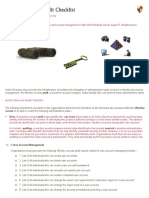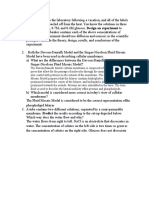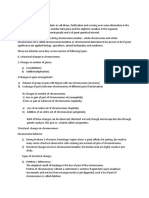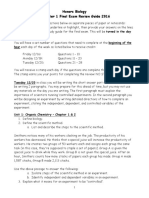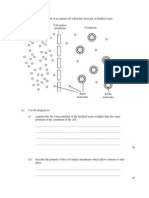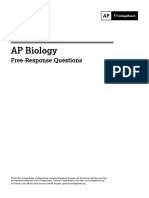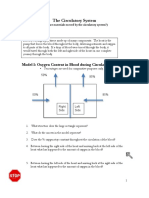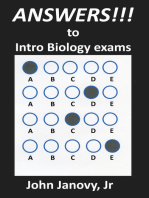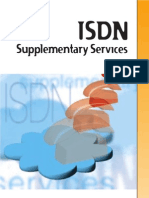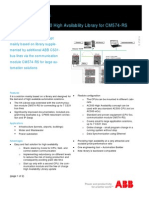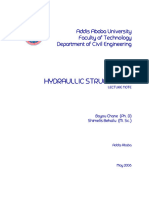AP Biology Chapter 17 Reading Guide
AP Biology Chapter 17 Reading Guide
Uploaded by
Sam BCopyright:
Available Formats
AP Biology Chapter 17 Reading Guide
AP Biology Chapter 17 Reading Guide
Uploaded by
Sam BCopyright
Available Formats
Share this document
Did you find this document useful?
Is this content inappropriate?
Copyright:
Available Formats
AP Biology Chapter 17 Reading Guide
AP Biology Chapter 17 Reading Guide
Uploaded by
Sam BCopyright:
Available Formats
AP Biology Reading Guide Chapter 17: From Gene to Protein
Fred and Theresa Holtzclaw
Name _______________________ Period ___________
Chapter 17: From Gene to Protein
This is going to be a very long journey, but it is crucial to your understanding of biology. Work on this
chapter a single concept at a time, and expect to spend at least 6 hours to truly master the material. To
give you an idea of the depth and time required, we have spent over 5 hours writing this Reading
Guide! You will need even longer to complete it and learn the information. Good luck, and take your
time.
Overview
1. What is gene expression?
Concept 17.1 Genes specify proteins via transcription and translation
2. What situation did Archibald Garrod suggest caused inborn errors of metabolism?
3. Describe one example Garrod used to illustrate his hypothesis.
4. State the hypothesis formulated by George Beadle while studying eye color mutations in
Drosophila.
5. What strategy did Beadle and Tatum adopt to test this hypothesis?
6. Which organism did Beadle and Tatum use in their research? How did this organism’s
nutritional requirements facilitate this research?
7. How were Neurospora spores treated to increase the mutation rate?
Copyright © 2010 Pearson Education, Inc. -1-
AP Biology Reading Guide Chapter 17: From Gene to Protein
Fred and Theresa Holtzclaw
8. Study Figure 17.2 carefully. On the figure below, outline the technique used to identify and
isolate mutant fungi.
9. Cite two significant findings that resulted from the research of Beadle and Tatum.
10. What revision of detail (but not of basic principle) did this hypothesis undergo as more
information was gained? Write this restatement and then box or highlight it. This is an
important concept!
Basic Principles of Transcription and Translation
This section will introduce you to the processes and associated terminology in the form of an
overview. Once you have the big picture, you will take a closer look in the next few concepts.
11. From the first paragraph in this section, find three ways in which RNA differs from DNA.
12. What are the monomers of DNA and RNA? Of proteins?
Copyright © 2010 Pearson Education, Inc. -2-
AP Biology Reading Guide Chapter 17: From Gene to Protein
Fred and Theresa Holtzclaw
13. Define each of these processes that are essential to the formation of a protein:
transcription
translation
14. Complete the following table to summarize each process.
Template Product Synthesized Location in Eukaryotic Cell
Transcription
Translation
15. In eukaryotes, what is the pre-mRNA called?
16. Write the central dogma of molecular genetics, as proclaimed by Francis Crick, in the box
below.
17. How many nucleotide bases are there? _______________ How many amino acids?
__________
18. How many nucleotides are required to code for these 20 amino acids? ___________________
19. So, the language of DNA is a triplet code. How many unique triplets exist? ______________
20. DNA is double-stranded, but for each protein, only one of these two strands is used to produce
an mRNA transcript. What is the coding strand called?
21. Here is a short DNA template. Below it, assemble the complementary mRNA strand.
3'A C G A C C A G T A A A 5'
Copyright © 2010 Pearson Education, Inc. -3-
AP Biology Reading Guide Chapter 17: From Gene to Protein
Fred and Theresa Holtzclaw
22. How many codons are there above? ________ Label one codon.
23. Describe Nirenberg’s experiment in which he identified the first codon.
24. What was the first codon–amino acid pair to be identified? __________________________
25. Of the 64 possible codons, how many code for amino acids? _________________________
26. What event is coded fro by UAA, UAG and UGA? ________________________________
27. What is the start codon? ____________________________________________________
28. Why is the genetic code said to be redundant but not ambiguous?
29. Explain the concept of reading frame.
30. Now here is an important idea: DNA is DNA is DNA. By this we mean that the code is nearly
universal, and because of this, jellyfish genes can be inserted into pigs, or firefly genes can
make a tobacco plant glow. Enjoy a look at Figure 17.6 in your text . . . and no question to
answer here!
Concept 17.2 Transcription is the DNA-directed synthesis of RNA: A closer look
31. Name the enzyme that uses the DNA template strand to transcribe a new mRNA strand.
32. You will recall from Chapter 16 that DNA polymerase III adds new nucleotides to the template
DNA strand to assemble each new strand of DNA. Both enzymes can assemble a new
polynucleotide only in the 5' Æ direction. Which enzyme, DNA polymerase III or RNA
polymerase, does not require a primer to begin synthesis?
33. What is a transcription unit?
Copyright © 2010 Pearson Education, Inc. -4-
AP Biology Reading Guide Chapter 17: From Gene to Protein
Fred and Theresa Holtzclaw
34. Figure 17.7 in your text will require a bit of study. Use it to label the following elements on the
figure below: promoter, RNA polymerase, transcription unit, DNA template, nontemplate DNA,
and RNA transcript. Then, to the right of the figure, name the three stages of transcription and
briefly describe each stage.
35. Let’s now take a closer look at initiation. Read the paragraph titled “RNA Polymerase Binding
and Initiation of Transcription” carefully. List three important facts about the promoter here.
(1)
(2)
(3)
Copyright © 2010 Pearson Education, Inc. -5-
AP Biology Reading Guide Chapter 17: From Gene to Protein
Fred and Theresa Holtzclaw
36. Use Figure 17.8 in your text to label the following elements of the figure below: TATA box,
RNA polymerase II, transcription factors, template DNA strand, start point, 5' and 3', and
mRNA transcript. To the right of the figure, explain the three stages of initiation that are shown.
37. What is the TATA box? How do you think it got this name?
38. What comprises a transcription initiation complex?
39. Now it is time to put all of the elements of transcription together. Write an essay below to
describe the process by which mRNA is formed. Use these terms correctly in your essay, and
underline each one: TATA box, gene, terminator, promoter, elongation, 5’ to 3', termination,
initiation RNA, polymerase RNA nucleotides, template, start point, termination signal, and
transcription factors. This essay is typical of what you might be asked to write on the AP
Biology exam.
__________________________________________________________________________________
__________________________________________________________________________________
__________________________________________________________________________________
__________________________________________________________________________________
Copyright © 2010 Pearson Education, Inc. -6-
AP Biology Reading Guide Chapter 17: From Gene to Protein
Fred and Theresa Holtzclaw
__________________________________________________________________________________
__________________________________________________________________________________
__________________________________________________________________________________
__________________________________________________________________________________
__________________________________________________________________________________
__________________________________________________________________________________
Concept 17.3 Eukaryotic cells modify RNA after transcription
40. RNA processing occurs only in eukaryotic cells. The primary transcript is altered at both ends,
and sections in the middle are removed.
a. What happens at the 5' end?
b. What happens at the 3' end?
41. What are three important functions of the 5' cap and poly-A tail?
42. Distinguish between introns and exons. Perhaps it will help to remember this: Exons are
expressed.
43. On the figure below, label: pre-mRNA, 5' cap, poly-A tail, introns, and exons.
Copyright © 2010 Pearson Education, Inc. -7-
AP Biology Reading Guide Chapter 17: From Gene to Protein
Fred and Theresa Holtzclaw
44. What are snRNPs? What two types of molecules make up a snurp? (We like the word snurp! It
reminds us of little cartoon characters that wore blue hoods and were called smurfs.
45. You will be introduced to a number of small RNAs in this course. What type is the RNA in a
snRNP?
46. Snurps band together in little snurp groups to form spliceosomes. How do spliceosomes work?
47. On the figure below, label the following: pre-mRNA, snRNPs, snRNA, protein, spliceosomes,
intron, and other proteins.
48. Study the figure and text carefully to explain how the splice sites are recognized.
49. What is a ribozyme?
Copyright © 2010 Pearson Education, Inc. -8-
AP Biology Reading Guide Chapter 17: From Gene to Protein
Fred and Theresa Holtzclaw
50. What commonly held idea was rendered obsolete by the discovery of ribozymes?
51. What are three properties of RNA that allow it to function as an enzyme?
(1)
(2)
(3)
52. What is the consequence of alternative splicing of identical mRNA transcripts?
Concept 17.4 Translation is the RNA-directed synthesis of a polypeptide: A closer look
53. You may need to read on in this section in order to answer this question as well as think back to
earlier information about mRNA. Come back to this question later if you wish. Three types of
RNA are needed for protein synthesis. Complete the chart below.
Type of RNA Description Function
mRNA
tRNA
rRNA
54. What is an anticodon?
Copyright © 2010 Pearson Education, Inc. -9-
AP Biology Reading Guide Chapter 17: From Gene to Protein
Fred and Theresa Holtzclaw
55. Transfer RNA has two attachment sites. What binds at each site? Sketch tRNA, indicate the 2
attachment sites, and note where complementary base pairing and hydrogen bonding occur to
give tRNA its shape.
56. How many different aminoacyl-tRNA synthetases are there? ____________________________
57. Scientists expected to find one aminoacyl-tRNA synthetase per codon, but far fewer have been
discovered. How does wobble explain this?
58. Use the figure below to explain the process of a specific amino acid being joined to a tRNA.
Also add these labels: aminoacyl-tRNA synthetase, ATP, amino acid, and tRNA.
Copyright © 2010 Pearson Education, Inc. - 10 -
AP Biology Reading Guide Chapter 17: From Gene to Protein
Fred and Theresa Holtzclaw
59. Describe the structure of a eukaryotic ribosome.
60. How does a prokaryotic ribosome differ from a eukaryotic ribosome? What is the medical
significance of this difference?
61. On this figure, label the large subunit, small subunit, A, P, and E sites, mRNA binding site. To
the right of the figure, explain the functions of the A, P, and E sites.
62. Much like transcription, we can divide translation into three stages. List them.
63. Summarize the events of initiation. Include these components: small ribosomal subunit, large
ribosomal subunit, mRNA, initiator codon, tRNA, Met, initiation complex, P site, and GTP. The
figure below may help you.
Copyright © 2010 Pearson Education, Inc. - 11 -
AP Biology Reading Guide Chapter 17: From Gene to Protein
Fred and Theresa Holtzclaw
64. What is always the first amino acid in the new polypeptide?
65. Now, summarize the events of elongation. Include these components: mRNA, A site, tRNA,
codon, anticodon, ribozyme, P site, and E site. Again, the figure may help you.
66. What is a release factor? By what mechanism is termination accomplished?
67. What is a polyribosome?
68. What are some of the things that will result in a final-form functional protein?
Copyright © 2010 Pearson Education, Inc. - 12 -
AP Biology Reading Guide Chapter 17: From Gene to Protein
Fred and Theresa Holtzclaw
69. Describe at least three types of post-translational modifications.
70. Use the following figure to explain how proteins are targeted for the ER.
Concept 17.5 Point mutations can affect protein structure and function
71. Define a mutation in terms of molecular genetics.
72. Define point mutations.
73. What are frameshift mutations?
Copyright © 2010 Pearson Education, Inc. - 13 -
AP Biology Reading Guide Chapter 17: From Gene to Protein
Fred and Theresa Holtzclaw
74. Identify two mechanisms by which frameshifts may occur.
75. What is the difference between a nonsense and missense mutation?
76. How can a base-pair substitution result in a silent mutation?
77. What are the two categories of mutagens?
78. Describe the action of difference types of chemical mutagens.
Concept 17.6 Although gene expression differs among the domains of life, the concept of a gene is
universal
79. Describe two important ways in which bacterial and eukaryotic gene expression differ.
80. What is a gene? It used to be simply stated that one gene codes for one polypeptide. That
definition has now been modified. Write below the broader molecular definition in use today.
Copyright © 2010 Pearson Education, Inc. - 14 -
AP Biology Reading Guide Chapter 17: From Gene to Protein
Fred and Theresa Holtzclaw
81. Finally, use this summary figure to put together all that you have learned in this chapter.
Testing Your Knowledge: Self-Quiz Answers
Now you should be ready to test your knowledge. Place your answers here:
1. __________2.__________3. __________4. __________5. __________6. __________7. _________
Copyright © 2010 Pearson Education, Inc. - 15 -
You might also like
- Active Directory Audit ChecklistDocument3 pagesActive Directory Audit ChecklistChirri Corp75% (4)
- AP Biology Reading Guide Chapter 14Document26 pagesAP Biology Reading Guide Chapter 14starynightz75% (4)
- CH 10 Tests A, B, CDocument9 pagesCH 10 Tests A, B, CMostafa BayoumyNo ratings yet
- AP Biology Chaper 51 Reading GuideDocument7 pagesAP Biology Chaper 51 Reading GuideLa-MarcusSmith-Kelley0% (2)
- AP Biology 1st Semester Final Exam Review-2011.2012Document13 pagesAP Biology 1st Semester Final Exam Review-2011.2012Jessica ShinNo ratings yet
- AP Biology Reading Guide Chapter 23Document12 pagesAP Biology Reading Guide Chapter 23shkjsdhfskjd60% (5)
- Chapter 14 AP Biology OutlineDocument15 pagesChapter 14 AP Biology OutlinegahaganeNo ratings yet
- EOC Biology Practice Assessment FinalDocument22 pagesEOC Biology Practice Assessment FinalehshonorsbioNo ratings yet
- A View of The Cell Review PacketDocument7 pagesA View of The Cell Review Packetapi-259727482No ratings yet
- AP Bio Lab GuideDocument2 pagesAP Bio Lab GuideSteven TruongNo ratings yet
- 15 20Document97 pages15 20dianaNo ratings yet
- Math 1 AllDocument115 pagesMath 1 AlldenitsaNo ratings yet
- 95010103434742771Document16 pages95010103434742771pirya836100% (1)
- Chapter 16 Molecular Basis of InheritanceDocument8 pagesChapter 16 Molecular Basis of InheritanceMahesh T MadhavanNo ratings yet
- Ap Biology PracticeDocument4 pagesAp Biology PracticeHarun KianiNo ratings yet
- AP Biology - Chapter 1 Discussion AnswersDocument3 pagesAP Biology - Chapter 1 Discussion Answersangel91me6371100% (8)
- Gene Expression and Regulation: Ap BiologyDocument16 pagesGene Expression and Regulation: Ap BiologyFb EyeNo ratings yet
- AP Biology Worksheet Pedigrees 2Document2 pagesAP Biology Worksheet Pedigrees 2Victoria LowmanNo ratings yet
- Name: - Date: - Period: - AP Biology Genetics Problems PracticeDocument5 pagesName: - Date: - Period: - AP Biology Genetics Problems PracticesandsphilipNo ratings yet
- Chapter 8, 9, 10 Review - Pre-AP BiologyDocument3 pagesChapter 8, 9, 10 Review - Pre-AP BiologyTheGeekSquadNo ratings yet
- Chromosomel Structure and MutDocument4 pagesChromosomel Structure and MutAbhishek SinghNo ratings yet
- AP Biology Syllabus 2021Document15 pagesAP Biology Syllabus 2021israa jaaboNo ratings yet
- Honors Biology - Final Exam Review, KirkpatrickDocument4 pagesHonors Biology - Final Exam Review, KirkpatrickJoseph LeeNo ratings yet
- AP Biology Unit 5-Heredity: MeiosisDocument7 pagesAP Biology Unit 5-Heredity: MeiosisSam SankarNo ratings yet
- Problem Set 1 Introduction and Cell SignalingDocument9 pagesProblem Set 1 Introduction and Cell SignalingPreston Adhikari100% (1)
- Directions (As You Will See On The AP Biology Exam) Answers Must Be in EssayDocument5 pagesDirections (As You Will See On The AP Biology Exam) Answers Must Be in Essaybetaman99No ratings yet
- AP Biology Unit 2 - Cell Structure and FunctionDocument12 pagesAP Biology Unit 2 - Cell Structure and FunctionSam SankarNo ratings yet
- AP Biology Evolution VocabDocument3 pagesAP Biology Evolution VocabOhhgeeee100% (1)
- AP Biology Lab #4Document10 pagesAP Biology Lab #4Adrienne HarreveldNo ratings yet
- Latihan MitosisDocument7 pagesLatihan MitosisChe Mahani Hussain100% (1)
- AP Biology Unit 4 - Communication and Cell CycleDocument7 pagesAP Biology Unit 4 - Communication and Cell CycleSam SankarNo ratings yet
- Section 3.1 Solids, Liquids, and Gases: Reading StrategyDocument2 pagesSection 3.1 Solids, Liquids, and Gases: Reading StrategyensentisNo ratings yet
- Paper Practice Test With KEY AttachedDocument8 pagesPaper Practice Test With KEY AttachedmspallardNo ratings yet
- Chromosome Structure: Chromosomal Changes Occur in Three Basic Categories: Rearrangement, Aneuploidy, and PolyploidyDocument56 pagesChromosome Structure: Chromosomal Changes Occur in Three Basic Categories: Rearrangement, Aneuploidy, and PolyploidyBryce WatsonNo ratings yet
- AP Biology - Ecology - PracticeDocument8 pagesAP Biology - Ecology - PracticeVictoria LowmanNo ratings yet
- Notes Mendelian GeneticsDocument38 pagesNotes Mendelian Geneticsmattheo miyaNo ratings yet
- ds84 Unit 7 Assessment Intro To GeneticsDocument9 pagesds84 Unit 7 Assessment Intro To Geneticsapi-1107897020% (1)
- Ap BiologyDocument11 pagesAp BiologyChandra NekkantiNo ratings yet
- CK-12 Biology Chapter 24 WorksheetsDocument32 pagesCK-12 Biology Chapter 24 WorksheetsShermerNo ratings yet
- EOC BookletDocument33 pagesEOC BookletHalden LinNo ratings yet
- Biology Lab: Natural Selection and Allele FrequencyDocument3 pagesBiology Lab: Natural Selection and Allele FrequencynazrimuhsinNo ratings yet
- Chapter 12 PDFDocument14 pagesChapter 12 PDFJeanPaule Joumaa100% (1)
- Year 12 Additional Questions (Cell Transport)Document31 pagesYear 12 Additional Questions (Cell Transport)dramitrajp9602100% (2)
- Ch. 6 Active ReadingDocument13 pagesCh. 6 Active ReadingTaryn IndishNo ratings yet
- TB unit2frq1 5e7e0883156b31.63879203 加水印 加水印Document12 pagesTB unit2frq1 5e7e0883156b31.63879203 加水印 加水印y77811766No ratings yet
- Pretest 10Document5 pagesPretest 10Ghazi DallyNo ratings yet
- hssb0400s StudygdaDocument18 pageshssb0400s StudygdaMohamed HassaneinNo ratings yet
- 3.10 Practice KeyDocument8 pages3.10 Practice KeyHarvey Lloyd BatoonNo ratings yet
- Chapter 5 Active Reading Guide PDFDocument9 pagesChapter 5 Active Reading Guide PDFMcKenzie Swift-Ramirez50% (2)
- AP Bio Unit 3 Study Guide Chapter 14Document6 pagesAP Bio Unit 3 Study Guide Chapter 14Bashir McQueen100% (2)
- Cells: Unit 3: Subject Standards/Content and OST AlignmentDocument37 pagesCells: Unit 3: Subject Standards/Content and OST AlignmentCalebNo ratings yet
- Cheat Sheet Quiz 1Document2 pagesCheat Sheet Quiz 1Ryan ThorntonNo ratings yet
- AP Bio SyllabusDocument6 pagesAP Bio SyllabusLakerea BurrellNo ratings yet
- BiologyDocument387 pagesBiologyAaron Wong100% (1)
- AP Biology 2018 FRQ PDFDocument12 pagesAP Biology 2018 FRQ PDFJulie MaNo ratings yet
- Hardy Weinberg ProblemsDocument3 pagesHardy Weinberg Problemsmiaka96No ratings yet
- Circulation POGILDocument4 pagesCirculation POGILDave KNo ratings yet
- Biology Paper 2 (Question) LDocument15 pagesBiology Paper 2 (Question) Lhasimahazit75% (8)
- Science behind Non-specific Science: (For Molecular Biologist & Biotechnologist)From EverandScience behind Non-specific Science: (For Molecular Biologist & Biotechnologist)No ratings yet
- High School Biology: Questions & Explanations for Cell & Molecular BiologyFrom EverandHigh School Biology: Questions & Explanations for Cell & Molecular BiologyNo ratings yet
- Chapter 17: From Gene To ProteinDocument17 pagesChapter 17: From Gene To ProteinBen LucasNo ratings yet
- Chapter 17 AnswersDocument15 pagesChapter 17 AnswersBen LucasNo ratings yet
- RF and Antenna BasicsDocument69 pagesRF and Antenna BasicsEduardo Carrasquero50% (2)
- Sri - Dr.Gangadhara Rao Kancharla: IV Semester Mini-Project INDocument16 pagesSri - Dr.Gangadhara Rao Kancharla: IV Semester Mini-Project INVenkataramanareddy SuraNo ratings yet
- Roto CapDocument2 pagesRoto CapSWASTIK MISHRANo ratings yet
- Planning For Day of The DeadDocument1 pagePlanning For Day of The Deadapi-373656311No ratings yet
- Lupo 1.2 Tdi 3lDocument53 pagesLupo 1.2 Tdi 3lgoopejko100% (2)
- English As A Second Language in The Mainstream Teaching, Learning and IdentityDocument264 pagesEnglish As A Second Language in The Mainstream Teaching, Learning and IdentityYoussef AyadNo ratings yet
- Isdn Pocket Guide 1Document37 pagesIsdn Pocket Guide 1api-3722785No ratings yet
- BITI 1113 12223 Lab AssessmentDocument4 pagesBITI 1113 12223 Lab AssessmentJack frostNo ratings yet
- Study Literatur: Pengkajian Luka Kaki DiabetesDocument15 pagesStudy Literatur: Pengkajian Luka Kaki DiabetesoctaviamayvikaNo ratings yet
- 02AeroModeller February 1962Document52 pages02AeroModeller February 1962drakhencNo ratings yet
- Global Demography: SubtitleDocument32 pagesGlobal Demography: SubtitleEneb De OcampoNo ratings yet
- Instruction Manual: VideonicsDocument93 pagesInstruction Manual: VideonicsportalprofeticoNo ratings yet
- A Descriptive Study To Assess The Knowledge On Effects of Smoking and Alcoholism Among Adolescent Boys at ChennaiDocument3 pagesA Descriptive Study To Assess The Knowledge On Effects of Smoking and Alcoholism Among Adolescent Boys at ChennaiInternational Journal of Innovative Science and Research TechnologyNo ratings yet
- Pre-Assessment: Contemporary Philippine Arts From The RegionsDocument2 pagesPre-Assessment: Contemporary Philippine Arts From The RegionsRachelle OlañoNo ratings yet
- Nationalism and Musical Style in Interwar Yogaku - A ReappraisalDocument46 pagesNationalism and Musical Style in Interwar Yogaku - A ReappraisalMert AltuntaşNo ratings yet
- AC500 High Availability Library For CM574-RSDocument2 pagesAC500 High Availability Library For CM574-RSAkoKhalediNo ratings yet
- Directional CouplerDocument3 pagesDirectional Couplerzgxfsbjbn100% (1)
- PHYSICAL SCIENCE MODULE 3, Quarter 2Document18 pagesPHYSICAL SCIENCE MODULE 3, Quarter 2Kennedy Fieldad Vagay100% (4)
- Fraud in Insurance Suraj 1Document5 pagesFraud in Insurance Suraj 1Rupal Rohan DalalNo ratings yet
- COURSE SYLLABUS in (Code - Descriptive Title)Document7 pagesCOURSE SYLLABUS in (Code - Descriptive Title)Fernando BornasalNo ratings yet
- G 4 Stud Educ GarciaDocument13 pagesG 4 Stud Educ GarciaJean NiusNo ratings yet
- Ceraphant T PTC31, PTP31, PTP35: Operating InstructionsDocument32 pagesCeraphant T PTC31, PTP31, PTP35: Operating InstructionsWandesson DuarteNo ratings yet
- Euro Disney Case StudyDocument2 pagesEuro Disney Case StudyZidan ZaifNo ratings yet
- Turning Over A New Leaf The Health-Enabling Capacities of Nature Contact Inprison (D. Moran, 2019)Document8 pagesTurning Over A New Leaf The Health-Enabling Capacities of Nature Contact Inprison (D. Moran, 2019)Razi MahriNo ratings yet
- New Level 6 Mit App Inventor Image Puzzle AppDocument52 pagesNew Level 6 Mit App Inventor Image Puzzle AppRanjan ZambareNo ratings yet
- Hyd Stru MastDocument193 pagesHyd Stru MastaajifNo ratings yet
- STA641 Assignment SolutionDocument4 pagesSTA641 Assignment Solutionm.shahidNo ratings yet
